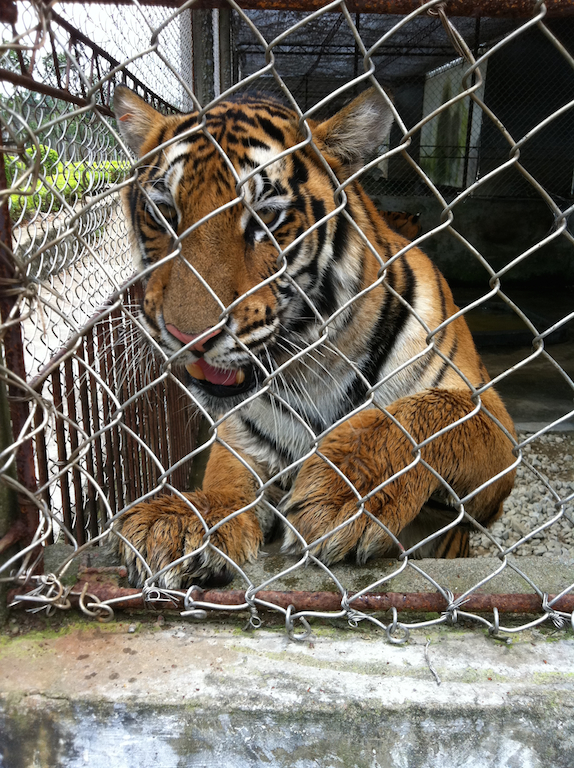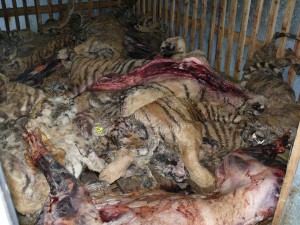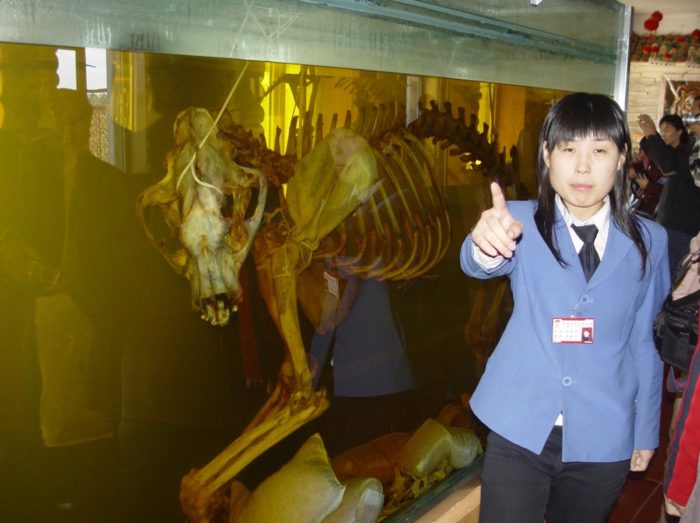World leaders are wasting time the tiger does not have
In January 2016, Parties to the UN Convention on International Trade in Endangered Species (CITES) will meet in Geneva and countries that care about the future of wild tigers will have an opportunity to get tough on those which have failed to do enough to end the demand that drives poaching and illegal trade.
There are as few as 3,200 wild tigers remaining, but at least there are encouraging signs of recovery in Nepal, Bhutan, the Russian Far East and parts of India. It remains an uphill battle – organised networks of poachers and traffickers are still targeting tigers, as well as other Asian big cats such as leopards and snow leopards as a substitute, to feed the Asian demand for skins, bones, meat and claws. More than 1,400 Asian big cats have been seized in trade since 2010.

Captive tiger in China, filmed during EIA undercover visit (c) EIA
Consumers in China, Vietnam and Chinese consumers in Lao PDR want tiger skins as rugs or mounted trophies with which to decorate the home, bones to make wine that is marketed as a prestigious gift in some countries and a virility tonic in others; meat is consumed as a delicacy, while teeth and claws are sold as charms.
It should come as no surprise that China has only an estimated 50 wild tigers left, while the wild tiger population is so low in Lao PDR and Vietnam it is considered functionally extinct.
These three countries, along with Thailand, are also home to tiger ‘farms’ where tigers are bred or kept in captivity and end up as body parts in the trade, fuelling the same demand that drives the poaching of wild tigers. These facilities range in scale from circuses and small private holdings or ‘zoos’ to facilities with more than 1,000 tigers. Of the 480 tigers seized in trade since 2010, 140 are suspected to have been bred or kept in captivity, or to have been illegally acquired and laundered through captive facilities.
In contrast to the principles and policies in south Asia and Russia, where the emphasis is on protection of the tiger in the wild, tigers in China, Laos, Vietnam and Thailand have been reduced to commodities. There are an estimated 7,000 tigers behind bars; they serve no conservation purpose but exist only to satisfy business and criminal interests.

Tiger bodies in cold storage at Guilin Tiger & Bear Farm (c) Belinda Wright
In China, wildlife law dating back to the 1980s encourages the breeding, domestication and utilisation of tigers, and permits are issued for domestic trade in the skins of captive-bred tiger skins. The Government admits it is unable to monitor this trade effectively and EIA investigators have met with licensed taxidermists who not only sell tiger skin rugs made from captive tigers but who illegally process the skins of wild tigers and abuse the system to sell tiger bone. Likewise in Laos, the law allows the breeding of tigers for domestic trade in body parts.
Trade, including domestic trade, in parts and derivatives of captive-bred tigers perpetuates the desirability of tiger parts and products, stimulating demand rather than reducing it. It also undermines enforcement efforts. That’s why, in 2007, at the 14th Conference of the Parties to CITES a Decision was adopted essentially stating that tigers should not be bred for trade in their parts and derivatives, and that tiger farms should be phased out.
Eight years on and – despite several appeals from India, the EU and USA for tiger farming countries to implement the Decision – tigers are still being bred for trade in their parts and derivatives. While this conservation threat is discussed at CITES, unlike the agenda items on elephants and rhinos it has not received the same enough-is-enough approach from concerned Parties.
In preparation for the 66th Meeting of the CITES Standing Committee (SC66) next January, draft proposals for further studies and reviews have been tabled for discussion. This is despite a comprehensive review on Asian big cat trade, including captive trade, being produced by the IUCN / WWF / TRAFFIC for the 65th Meeting of the CITES Standing Committee in July 2014. This included targeted recommendations, many of which were adopted by the CITES Standing Committee last year.

Vat of tiger bone wine in Harbin, China (c) Save The Tiger Fund
A Working Group was established to review implementation of these recommendations, of the main CITES Resolution on Asian big cats and Decision 14.69. While some best practice and progress was identified, rather than spending time reviewing implementation a considerable amount of time was wasted with just one Party, China, who happened to be the Chair of the Working Group, challenging Decisions and recommendations that had already been adopted by CITES.
“The international community is wasting precious time that the tiger does not have,” said Debbie Banks, Team Leader of EIA’s Tiger Campaign. “The CITES review of tiger and Asian big cat trade from last year is full of data, enough for the international community to move straight to tougher talk of trade suspensions and time-bound actions for Parties that are trading and consuming tiger parts from wild and captive-bred tigers”.
At the beginning of 2015, EIA participated in the Zero Poaching Symposium in Nepal where, in a poignant closing remark, the Secretary General of the Global Tiger Forum called for zero demand to support zero poaching.
“As we look to the beginning of a new year, the halfway point from the 2010 International Tiger Summit where world leaders pledged to double the wild tiger population by 2022, we have to ask where those world leaders are now?” added Banks.
“Real commitment to saving the wild tiger means changing policies and practice to end tiger farming and end all trade, domestic and international, in all parts and products of tigers, wild and captive.”

